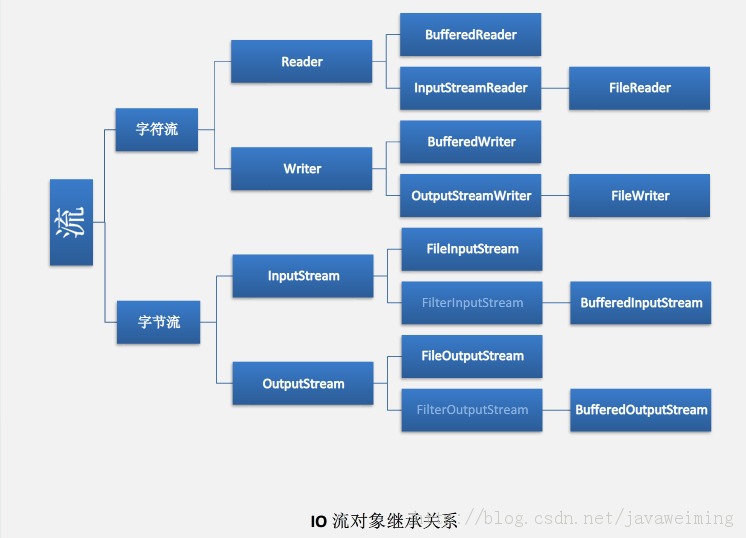IO流的分类:
1、根据流的数据对象来分:
高端流:所有的内存中的流都是高端流,比如:InputStreamReader
低端流:所有的外界设备中的流都是低端流,比如InputStream,OutputStream
如何区分:所有的流对象的后缀中包含Reader或者Writer的都是高端流,反之,则基本上为低端流,不过也有例外,比如PrintStream就是高端流
2、根据数据的流向来分:
输出流:是用来写数据的,是由程序(内存)--->外界设备
输入流:是用来读数据的,是由外界设备--->程序(内存)
如何区分:一般来说输入流带有Input,输出流带有Output
3、根据流数据的格式来分:
字节流:处理声音或者图片等二进制的数据的流,比如InputStream
字符流:处理文本数据(如txt文件)的流,比如InputStreamReader
如何区分:可用高低端流来区分,所有的低端流都是字节流,所有的高端流都是字符流
4、根据流数据的包装过程来分:
原始流:在实例化流的对象的过程中,不需要传入另外一个流作为自己构造方法的参数的流,称之为原始流。
包装流:在实例化流的对象的过程中,需要传入另外一个流作为自己构造方法发参数的流,称之为包装流。
如何区分:所以的低端流都是原始流,所以的高端流都是包装流
IO流对象的继承关系(如下图):

下面来看一些具体的代码例子:
按字节来读取文件
public class ReadFromFile { /** * 以字节为单位读取文件,常用于读二进制文件,如图片、声音、影像等文件。 */ public static void readFileByBytes(String fileName) { File file = new File(fileName); InputStream in = null; try { System.out.println("以字节为单位读取文件内容,一次读一个字节:"); // 一次读一个字节 in = new FileInputStream(file); int tempbyte; while ((tempbyte = in.read()) != -1) { System.out.print(tempbyte); } in.close(); } catch (IOException e) { e.printStackTrace(); return; } try { System.out.println("以字节为单位读取文件内容,一次读多个字节:"); // 一次读多个字节 byte[] tempbytes = new byte[100]; int byteread = 0; in = new FileInputStream(fileName); ReadFromFile.showAvailableBytes(in); // 读入多个字节到字节数组中,byteread为一次读入的字节数 while ((byteread = in.read(tempbytes)) != -1) { System.out.print(tempbytes, 0, byteread); } } catch (Exception e1) { e1.printStackTrace(); } finally { if (in != null) { try { in.close(); } catch (IOException e1) { } } } }
按字符来读取文件
/** * 以字符为单位读取文件,常用于读文本,数字等类型的文件 */ public static void readFileByChars(String fileName) { File file = new File(fileName); Reader reader = null; try { System.out.println("以字符为单位读取文件内容,一次读一个字符:"); // 一次读一个字符 reader = new InputStreamReader(new FileInputStream(file)); int tempchar; while ((tempchar = reader.read()) != -1) { // 对于windows下, 这两个字符在一起时,表示一个换行。 // 但如果这两个字符分开显示时,会换两次行。 // 因此,屏蔽掉 ,或者屏蔽 。否则,将会多出很多空行。 if (((char) tempchar) != ' ') { System.out.print((char) tempchar); } } reader.close(); } catch (Exception e) { e.printStackTrace(); } try { System.out.println("以字符为单位读取文件内容,一次读多个字符:"); // 一次读多个字符 char[] tempchars = new char[30]; int charread = 0; //由于要以字符来读取,所以需要套上字符流 reader = new InputStreamReader(new FileInputStream(fileName)); // 读入多个字符到字符数组中,charread为一次读取字符数 while ((charread = reader.read(tempchars)) != -1) { // 同样屏蔽掉 不显示 if ((charread == tempchars.length) && (tempchars[tempchars.length - 1] != ' ')) { System.out.print(tempchars); } else { for (int i = 0; i < charread; i++) { if (tempchars[i] == ' ') { continue; } else { System.out.print(tempchars[i]); } } } } } catch (Exception e1) { e1.printStackTrace(); } finally { if (reader != null) { try { reader.close(); } catch (IOException e1) { } } } }
按行来读取文件
/** * 以行为单位读取文件,常用于读面向行的格式化文件 */ public static void readFileByLines(String fileName) { File file = new File(fileName); BufferedReader reader = null; try { System.out.println("以行为单位读取文件内容,一次读一整行:"); reader = new BufferedReader(new FileReader(file)); String tempString = null; int line = 1; // 一次读入一行,直到读入null为文件结束 while ((tempString = reader.readLine()) != null) { // 显示行号 System.out.println("line " + line + ": " + tempString); line++; } reader.close(); } catch (IOException e) { e.printStackTrace(); } finally { if (reader != null) { try { reader.close(); } catch (IOException e1) { } } } }
将一个文件的内容写入另一个文件(按行来写)
public class FileTest { public static void main(String[] args) { File file=new File("c:\test.txt"); BufferedReader read=null; BufferedWriter writer=null; try { writer=new BufferedWriter(new FileWriter("c:\zwm.txt")); } catch (IOException e1) { e1.printStackTrace(); } try { read=new BufferedReader(new FileReader(file)); String tempString = null; while((tempString=read.readLine())!=null){ writer.append(tempString); writer.newLine();//换行 writer.flush();//需要及时清掉流的缓冲区,万一文件过大就有可能无法写入了 } read.close(); writer.close(); System.out.println("文件写入完成..."); } catch (IOException e) { e.printStackTrace(); } } }